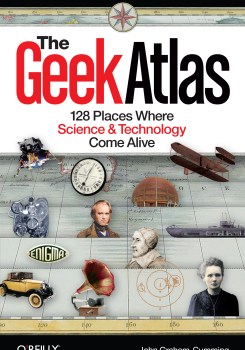The Antenna That Detected the Big Bang
An excerpt from “The Geek Atlas: 128 Places Where Science and Technology Come Alive.”

The following is an excerpt from The Geek Atlas, by John Graham-Cumming.
Horn Antenna, Holmdel, NJ
40° 23′ 26.61″ N, 74° 11′ 5.57″ W
Down a private road on top of Crawford Hill in Holmdel, New Jersey, is a 15-meter horn-shaped antenna built for Bell Labs and designed to pick up faint signals from an early NASA communications satellite. It achieved its purpose, and much more: the antenna ended up detecting signals that confirmed the Big Bang.
The Horn Antenna was built in 1959 as part of NASA’s Project Echo. Rather than using powered satellites for communication, as is done today, Project Echo involved placing 30- to 40-meter spherical balloons in orbit and bouncing microwave signals off them. In 1960 the Echo 1A satellite was successfully launched and placed in low Earth orbit. Echo 1A, weighing 76 kilograms and made of a mylar polyester film, showed that satellite communication would work: TV and radio signals were transmitted to it, bounced off it, and received.
On August 12, 1960, the Horn Antenna at Holmdel received a message transmitted from California and bounced off Echo 1A: “This is President Eisenhower speaking. This is one more significant step in the United States’ program of space research and exploration being carried forward for peaceful purposes. The satellite balloon, which has reflected these words, may be used freely by any nation for similar experiments in its own interest.”
In 1964, two scientists working on calibrating the Horn Antenna to remove interference were unable to identify a source of random noise. The antenna’s design was intended to eliminate noise from the surroundings; it was cooled to just above Absolute Zero to eliminate noise from the heat of the receiver; and the scientists chased off pigeons that contaminated the antenna interior with their droppings. The scientists had even placed metal tape over protruding rivets to try to achieve silence.

But a microwave noise remained. The scientists, Arno Penzias and Robert Wilson, determined that the noise was present day and night. By moving the antenna, which was built to examine any part of the sky, they found that the noise was present no matter where they looked.
In fact, they had discovered a trace of the Big Bang: cosmic background microwave radiation. The noise being received on a microwave wavelength of 7.35 centimeters (the wavelength at which the antenna’s receiver was built to operate) had been predicted since the 1940s. With its detection, the Big Bang theory prevailed over other rival explanations for the origin of the universe, and Penzias and Wilson were awarded the Nobel Prize.
Today the antenna is a National Historic Monument and is easily seen from the road. It sits on a rotating base and is attached directly to a small hut, where the receiving equipment was located. The entire antenna (but not the hut) can rotate on its axis to point at different parts of the sky. It is no longer in use.
Practical Information
At the entrance to Bell Labs’ old Holmdel site at 101 Crawfords Corner Road, there’s a water tower billed as the World’s Largest Transistor (Bell Labs was the home of the first transistor, although it looked nothing like the water tower). Continuing northwest on Crawfords Corner Road, you’ll reach a junction where you turn right onto Holmdel Road. The antenna is on a private road off of Holmdel Road; turn right after you’ve passed Longview Drive.
Copyright © 2009 John Graham-Cumming. All rights reserved. Published by O’Reilly Media, Inc.
John Graham-Cumming is a programmer and author of The Geek Atlas (O’Reilly, 2009) based in London, England.